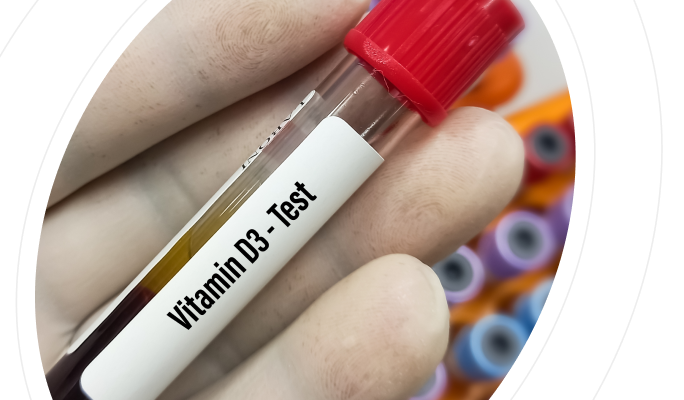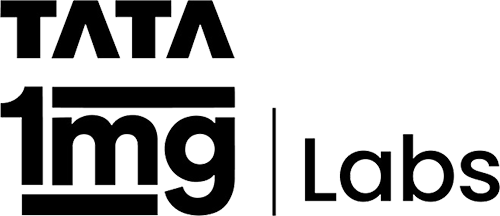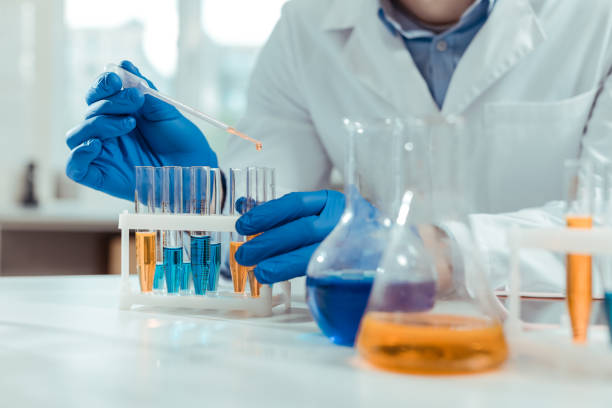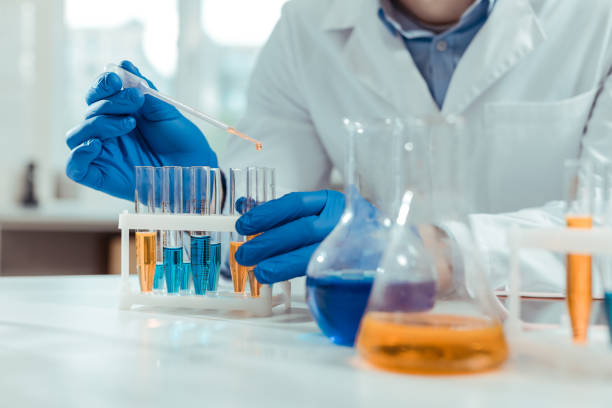Vitamin D3 (25 Hydroxy)
Amongst all the essential nutrients, few hold as much importance as Vitamin D3, also known as 25-hydroxy or 25-hydroxycholecalciferol. Often referred to as the ‘sunshine vitamin’, Vitamin D3 plays a crucial role in maintaining overall health and well-being. But what exactly is Vitamin D3 (25-hydroxy), and why is it so vital for our bodies? Read this detailed blog to find out why!
Vitamin D3 (25 Hydroxy) Test Price in Dayalbagh - Compare Prices at 15 Labs
Name
Proc. Time
Rating
Price
The Importance of Vitamin D3
Vitamin D3 (25-hydroxy) serves several essential functions within the body, contributing to overall health and well-being. Here are some of its key responsibilities:
Bone Health: Vitamin D3 (25-hydroxy) plays a vital role in promoting bone health by enhancing the absorption of calcium and phosphorus from the intestine. These minerals are essential for the formation and maintenance of strong, healthy bones. Adequate levels of Vitamin D3 (25-hydroxy) help prevent conditions such as osteoporosis and rickets, which are characterized by weakened bones.
Immune Function: Emerging research suggests that Vitamin D3 (25-hydroxy) plays a significant role in modulating the immune system. It helps regulate immune responses, enhances the function of immune cells, and contributes to the body's defense against infections. Adequate levels of Vitamin D3 (25-hydroxy) may help reduce the risk of autoimmune diseases, such as multiple sclerosis, and lower the susceptibility to infections.
Muscle Function: Vitamin D3 (25-hydroxy) is essential for maintaining optimal muscle function and strength. It helps regulate muscle contraction and relaxation, which is crucial for mobility, balance, and overall physical performance. Adequate levels of Vitamin D3 (25-hydroxy) can help reduce the risk of muscle weakness, falls, and fractures, particularly in older adults.
Mood Regulation: Some studies suggest a link between Vitamin D3 (25-hydroxy) levels and mood regulation. Adequate levels of Vitamin D3 (25-hydroxy) may play a role in reducing the risk of depression, anxiety, and other mood disorders. Vitamin D receptors are present in areas of the brain involved in mood regulation, indicating its potential influence on mental well-being.
Heart Health: There is evidence to suggest that Vitamin D3 (25-hydroxy) may have beneficial effects on cardiovascular health. It may help regulate blood pressure, improve endothelial function, and reduce the risk of cardiovascular diseases, such as heart attack and stroke. However, more research is needed to fully understand the relationship between Vitamin D3 (25-hydroxy) and heart health.
Sunlight: The primary source of Vitamin D3 is sunlight. When ultraviolet B (UVB) rays from the sun penetrate the skin, they trigger the synthesis of Vitamin D3 in the body. However, factors such as geographical location, time of day, season, skin pigmentation, and sunscreen use can affect the amount of Vitamin D3 produced.
Diet: While relatively few foods naturally contain Vitamin D3, some dietary sources include fatty fish (such as salmon, mackerel, and tuna), egg yolks, cheese, and fortified foods like milk, orange juice, and cereal. However, it can be challenging to obtain sufficient Vitamin D3 from diet alone.
Supplements: For individuals at risk of Vitamin D3 deficiency or those unable to get an adequate amount through sunlight and diet alone, supplements are available. These supplements typically come in the form of Vitamin D3 (cholecalciferol) capsules or tablets and should be taken under the guidance of a healthcare professional.
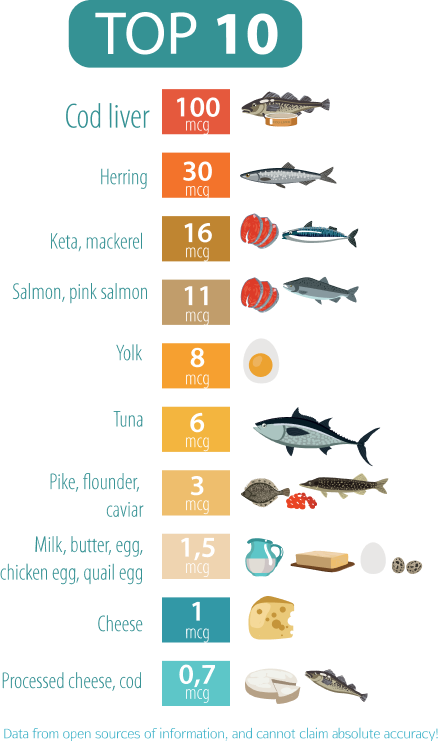
Sources of Vitamin D3
| Food | Vitamin D (mcg) |
|---|---|
| Cod liver oil, 1 tablespoon | 34 |
| Trout (rainbow), farmed, cooked, 3 ounces | 16.2 |
| Salmon (sockeye). cooked, 3 ounces | 14.2 |
| Mushrooms, white, raw, sliced, exposed to UV light, 1/2 cup | 9.2 |
| Milk, 2% milk fat, vitamin D fortifies, 1 cup | 2.9 |
| Sardines (atlantic), canned in oil, darined, 2 sardines | 1.2 |
| Soy, almond and oat milks, vitamin D fortified, 1 cup. | 2.5-3.5 |
| Ready to eat cereals, fortified with 10 % of the DIV for Vitamin D, 1 serving | 2.0 |
| Egg. 1 large, scrambled (vitamin D is in yolk) | 1.1 |
| Liver, beef, braised, 3 ounces | 1.0 |
| Tuna fish (light), canned in water drained, 3 ounces | 1.0 |
| Cheese, cheddar, 1 ounce | 0.3 |
| Mushrooms, portabella. raw, diced, 1/2 cup | 0.1 |
| Chicken breast, roasted, 3 ounces | 0.1 |
What Is The Vitamin D3 (25-Hydroxy) Test?
The Vitamin D3 (25-hydroxy) test, also known simply as the Vitamin D test or 25-hydroxy vitamin D test, is a blood test that measures the level of Vitamin D3 (25-hydroxycholecalciferol) in the blood. This test is used to assess an individual's Vitamin D status and determine whether they have adequate levels of Vitamin D or if they are deficient. . This test is also known as the 25-OH vitamin D test and the calcidiol 25-hydroxycholecalcifoerol test.
Recommended Vitamin D Intake By Age
| Life Stage | IU Per Day | mcg Per Day |
|---|---|---|
| Birth to 12 months | 400 IU | 10 mcg |
| Children and teens | 600 IU | 15 mcg |
| Adults, up to 70 | 600 IU | 15 mcg |
| Adults, ages 71+ | 800 IU | 20 mcg |
| Pregnant and breastfeeding women | 600 IU | 15 mcg |
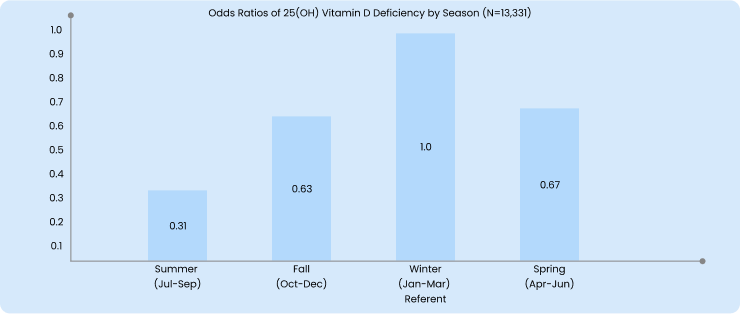
Purposes Of The Vitamin D3 (25-Hydroxy) Test
Assessing Vitamin D Status: Vitamin D is crucial for various physiological functions in the body, including bone health, immune function, and regulation of calcium metabolism. By measuring the concentration of 25-hydroxy vitamin D, this test helps healthcare professionals evaluate an individual's Vitamin D status accurately.
Detecting Deficiency or Insufficiency: Vitamin D deficiency is a prevalent health concern worldwide, with significant implications for bone health and overall well-being. The test enables healthcare providers to identify individuals who may have insufficient Vitamin D levels, allowing for timely intervention and management.
Guiding Treatment and Prevention: For individuals with Vitamin D deficiency or insufficiency, the results of the Vitamin D3 (25-Hydroxy) test help guide appropriate treatment strategies. This includes Vitamin D supplements, dietary changes, and lifestyle modifications to optimise Vitamin D levels and mitigate associated health risks.
Monitoring Vitamin D Levels: The Vitamin D3 (25-Hydroxy) test is also valuable for monitoring changes in Vitamin D levels over time. Regular testing allows healthcare providers to track the effectiveness of interventions and adjust treatment plans as needed to maintain optimal Vitamin D status.
What Health Conditions Can Be Detected Through A Vitamin D3 (25-Hydroxy) Test?
Vitamin D Deficiency: The Vitamin D3 (25-Hydroxy) test is primarily used to diagnose Vitamin D deficiency. Low levels of Vitamin D can lead to health problems such as weakened bones, increased risk of fractures, and osteoporosis.
Osteoporosis: Vitamin D plays a crucial role in calcium absorption, which is essential for maintaining bone health. Low Vitamin D levels can contribute to osteoporosis, a condition characterised by weakened bones and increased risk of fractures.
Rickets: In children, severe Vitamin D deficiency can lead to rickets, a condition characterised by soft, weak bones. The Vitamin D3 (25-Hydroxy) test can help diagnose Vitamin D deficiency in children and prevent the development of rickets.
Muscle Weakness and Pain: Vitamin D deficiency has been associated with muscle weakness and pain. Individuals with low Vitamin D levels may experience symptoms such as muscle aches, weakness, and difficulty walking. The Vitamin D3 (25-Hydroxy) test can help identify Vitamin D deficiency as a potential cause of these symptoms.
Increased Risk of Falls: Low Vitamin D levels have been linked to an increased risk of falls, particularly in older adults. The Vitamin D3 (25-Hydroxy) test can help identify individuals at risk of falls due to Vitamin D deficiency and guide interventions to reduce this risk.
Immune System Dysfunction: Vitamin D plays a role in immune system function, and low Vitamin D levels have been associated with an increased risk of infections and autoimmune diseases. The Vitamin D3 (25-Hydroxy) test can help identify individuals with Vitamin D deficiency who may be at risk of immune system dysfunction.
Depression and Mood Disorders: Some research suggests a link between Vitamin D deficiency and depression and other mood disorders. The Vitamin D3 (25-Hydroxy) test can help identify individuals with low Vitamin D levels who may benefit from interventions to improve mood and mental well-being.
The Following individuals should get tested:-
Those who living in regions with little sunlight
Those who spend most of their time outdoors
Individuals who consistently use sunscreen
People with darker Skin pigmentation
Older adults or individuals who are obese
Those with medical conditions affecting kidney function
People with darker Skin pigmentation
Older adults or individuals who are obese
Those with medical conditions affecting kidney function
Signs of vitamin D Deficiency
 Bone Loss
Bone Loss Fatigue
Fatigue Bone & Joint Pain
Bone & Joint Pain(Especially in your back)
 Muscle Cramps
Muscle Cramps(Or Weakness)
 Mood Changes
Mood ChangesVitamin D
Symptoms of low vitamin D (Vitamin D Deficiency)
Extreme fatigue and tiredness
Pain in bones and lower back
Slow wound healing
Bone loss
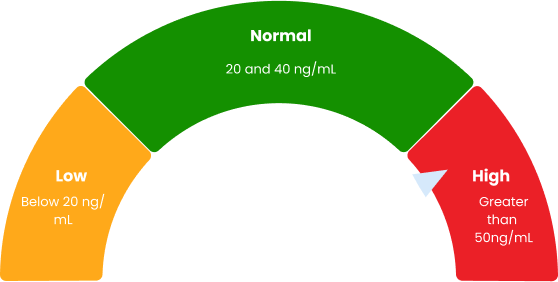
Vitamin D
Symptoms of High vitamin D (Vitamin D Toxicity)
Nausea
Vomiting
Muscle weakness
Frequent urination
Appetite loss
How Is This Test Done?
Blood Sample Collection: In this step, a trained healthcare professional will typically collect a blood sample from a vein, commonly located in the arm. To ensure a sterile procedure, the area where the needle will be inserted is cleaned with an antiseptic. A tourniquet may be applied above the intended puncture site to make the veins more visible and easier to access.
Venipuncture: Using a sterile needle, the healthcare professional will then puncture the vein to draw blood into one or more vacuum-sealed tubes attached to the needle. The needle is inserted swiftly and carefully to minimise discomfort, and the required volume of blood is collected.
Bandaging: Once an adequate blood sample has been obtained, the needle is removed, and pressure is applied to the puncture site using gauze or cotton. This pressure helps to stop any bleeding and promotes clotting. A bandage or adhesive strip is then applied to cover the puncture site and prevent bleeding or injury.
Sample Processing: After collection, the blood sample is processed in the laboratory. It undergoes centrifugation, a process that separates the serum (the liquid portion of blood) from the cellular components. The serum is then isolated and prepared for analysis.
Laboratory Analysis: In the laboratory, the serum sample is subjected to specialised techniques to measure the concentration of 25-hydroxy vitamin D accurately. Common methods include immunoassays and high-performance liquid chromatography (HPLC). These techniques provide precise measurements of Vitamin D levels, which are reported in units such as nanograms per milliliter (ng/mL) or nanomoles per liter (nmol/L).
How To Prepare For The Test?
Consult Your Healthcare Provider: Before scheduling the test, consult your healthcare provider to discuss the need for the test and any symptoms you may be experiencing. Also, inform them about any medications or supplements you are taking, as certain medications and supplements can affect Vitamin D levels. They can provide specific instructions based on your individual circumstances and may advise you to temporarily stop taking certain medications or supplements before the test, but do not do anything without consulting them.
Fasting: In most cases, fasting is not required before a Vitamin D3 (25-Hydroxy) test. You can typically eat and drink normally before the test.
Medication and Supplement Use: Inform your healthcare provider about any medications or supplements you are taking, as certain medications and supplements can affect Vitamin D levels.
Sunscreen Use: Avoid applying sunscreen to the area where blood will be drawn, as sunscreen can interfere with the test results. If possible, avoid sunscreen on the day of the test or apply it after the blood sample has been collected.
Stay Hydrated: Drink plenty of water before the test to ensure that you are adequately hydrated. Being well-hydrated can make it easier for the healthcare professional to draw blood and can help prevent dizziness or lightheadedness during or after the test.
Understanding The Results Of A Vitamin D3 Test
The normal range for Vitamin D3 (25-hydroxy) levels can vary slightly depending on the lab and units of measurement used. However, generally accepted ranges for Vitamin D3 levels in the blood are as follows:
Deficiency: Less than 30 nmol/L (12 ng/mL)
Potential Deficiency: Between 30 nmol/L (12 ng/mL) and 50 nmol/L (20 ng/mL)
Normal Levels: Between 50 nmol/L (20 ng/mL) and 125 nmol/L (50 ng/mL)
High Levels: Higher than 125 nmol/L (50 ng/mL)
Deficient
<30 ng/ml<75 nmol/L
Insufficient
30-50 ng/ml75-125 nmol/L
Optimal
50-70 ng/ml125-175 nmol/L
Cancer and heart disease therapy
70-100 ng/ml175-250 nmol/L
Excess
>100 ng/ml>250 nmol/L
Interpretation Of Vitamin D3 Test Results
Risks Associated With A Vitamin D3 Test
Discomfort or Pain: Some individuals may experience mild discomfort or pain during the blood draw process. This is typically temporary and resolves quickly after the procedure.
Bruising or Bleeding: After the blood draw, there is a slight risk of bruising or bleeding at the puncture site. Applying pressure to the site after the needle is removed can help minimise these risks.
Infection: Infection at the puncture site is rare but possible. Healthcare professionals follow strict protocols to maintain sterile conditions during blood collection to minimise the risk of infection.
Fainting or Dizziness: Some individuals may feel faint or dizzy during or after the blood draw, particularly if they are sensitive to needles or blood. It's essential to inform the healthcare provider if you have a history of fainting or dizziness during medical procedures.
False Positives or False Negatives: While the Vitamin D3 (25-Hydroxy) test is highly accurate, there is a small chance of false-positive or false-negative results. Factors such as laboratory error, sample handling, and underlying medical conditions can affect the accuracy of test results.
Overdiagnosis or Overtreatment: Interpreting test results requires careful consideration of individual health factors and clinical context. Overdiagnosis of Vitamin D deficiency or overtreatment with supplements can lead to unnecessary interventions and potential adverse effects.
Excessive Supplementation: Taking high doses of Vitamin D supplements without medical supervision can lead to Vitamin D toxicity, which can cause symptoms such as nausea, vomiting, weakness, and kidney damage.
The Vitamin D3 (25-Hydroxy) test, while valuable for assessing Vitamin D levels, carries certain risks. One potential risk is the discomfort or pain associated with the blood draw procedure, particularly for individuals sensitive to needles. Additionally, there's a slight risk of bleeding or bruising at the puncture site post-test. In rare cases, individuals may experience fainting or dizziness during or after the blood draw. It's also important to note that misinterpretation of test results or reliance on the test alone without proper medical consultation could lead to incorrect diagnosis or unnecessary treatment. Therefore, it's crucial to weigh the benefits against potential risks and always consult a healthcare professional for proper guidance and interpretation of results.Book a Vitamin D3 (25-Hydroxy) Test in Dayalbagh for ONLY ₹649*
What Measures Can Be Taken To Improve Vitamin D3 Levels?
Sunlight Exposure: Sunlight is a primary source of Vitamin D synthesis in the skin. Aim for moderate sun exposure, particularly during midday hours when UVB rays are strongest. Expose arms, legs, back, or face to sunlight for about 10-30 minutes, depending on factors like skin type and location. However, practice sun safety to prevent sunburn and skin damage, avoiding prolonged exposure during peak UV index hours.
Dietary Sources: Include Vitamin D-rich foods in your diet such as fatty fish, egg yolks, fortified dairy products, fortified cereals, and fortified plant-based milk alternatives. Regularly incorporating these foods into meals can help meet daily Vitamin D requirements and support overall health.
Supplementation: Consider taking a Vitamin D supplement if sunlight exposure and dietary sources are insufficient. Consult with a healthcare provider to determine the appropriate dosage based on factors like age, health status, and risk factors for deficiency. Opt for a high-quality supplement containing Vitamin D3 for optimal absorption and effectiveness.
Regular Testing: Periodically monitor Vitamin D levels through blood tests like the Vitamin D3 (25-Hydroxy) test to assess status and adjust supplementation or lifestyle strategies as needed. Discuss test results with a healthcare provider to interpret findings and make informed decisions about supplementation and other interventions.
Maintain A Healthy Lifestyle: Maintain a balanced diet rich in nutrients, engage in regular physical activity, and maintain a healthy body weight. These lifestyle factors can support overall health and well-being, including Vitamin D metabolism and absorption.
Food Sources of Vitamin D
| Food | IUs Per Serving | % Daily Value (DV) |
|---|---|---|
| Cod liver oil, 1 tablespoon | 1300 | 340 |
| Swordfish, Cooked 3 ounces | 566 | 142 |
| Salmon (sockeye). cooked, 3 ounces | 447 | 112 |
| Tuna fish, canned in water drained, 3 ounces | 154 | 39 |
| Orange juice fortified with vitamin D, 1 cup (check product labels) | 137 | 34 |
| Milk, nonfat, reduced fat, and whole, vitamin D fortified, 1 cup | 115-124 | 29-31 |
| Yogurt, fortified with 20% of the DV for vitamin D, 6 ounces | 80 | 20 |
| Margarine, fortified, 1 tablespoon | 60 | 15 |
| Sardines, canned in oil, drained, 2 sardines | 46 | 12 |
| Liver, beef, cooked, 3 ounces | 42 | 11 |
| Egg, 1 large (vitamin D is found in yolk) | 41 | 10 |
| Ready-to-eat cereal, fortified with 10% DV of vitamin D, 0.75-1 cup | 40 | 10 |
| Cheese, Swiss, 1 ounce | 6 | 2 |
Conclusion
The Vitamin D3 (25-Hydroxy) test serves as a crucial tool for assessing an individual's Vitamin D status and guiding appropriate interventions to optimise health. By measuring the concentration of 25-hydroxy vitamin D in the bloodstream, this test helps healthcare providers diagnose Vitamin D deficiency or insufficiency, detect related health conditions, and monitor Vitamin D levels over time. Interpretation of test results involves understanding the normal range and implications for Vitamin D status, considering factors such as sunlight exposure, dietary intake, supplementation, and overall lifestyle. With appropriate measures, including sunlight exposure, dietary changes, supplementation, regular testing, and maintaining a healthy lifestyle, individuals can work towards optimising Vitamin D3 levels and supporting bone health, immune function, and overall well-being. It's essential to consult with a healthcare provider for personalised guidance and recommendations based on individual needs and circumstances. Overall, the Vitamin D3 (25-Hydroxy) test plays a valuable role in promoting optimal health and wellness.Book a Vitamin D3 (25-Hydroxy) Test in Dayalbagh for ONLY ₹649*
*T&Cs Apply
